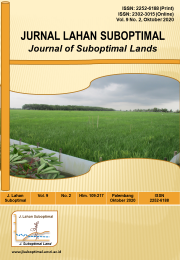Land Suitability Assessment for Some Carbohydrate Food Crops at Wetland Area in Arisan Jaya
DOI:
https://doi.org/10.33230/JLSO.9.2.2020.470Keywords:
cassava, corn, dry land rice, wet land rice, sweet potatoAbstract
Priatna SJ, Rahman D, Supriyadi S. 2020. Land suitability assessment for some carbohydrate food crops at wetland area in Arisan Jaya. Jurnal Lahan Suboptimal : Journal of Suboptimal Lands 9(2): 117-126.
The nature condition and lack of knowledge about soil characteristics have become a limitation for crops cultivation and development in Arisan Jaya. This study aimed to determine the type of crops that has potential to be developed in site. The assessment was carried out in Arisan Jaya, Pemulutan Barat Sub-District, Ogan Ilir Regency, South Sumatera from April to August 2015. The study method is 1:30.000 semi-detailed survey. The location of the sample was determined by grid method with one sample for every 1.000 meters with 10 sample sites. A disturbed soil sample was taken as deep as 150 cm from the ground surface. Land characteristics data were matched with crops growth requirements based on the suitability classes set for wetland rice, dry land rice, corn, cassava and sweet potato. The distribution of soil properties was known by IDW (Inverse Distance Weighting) interpolation method, which was overlapped to determine the distribution of land suitability classes. Very acidic soil conditions was a major limiting factor for crops cultivation in general (the actual suitability class is Nf). Wetland rice was relatively more suitable to be cultivated than dryland rice in the site. Corn and cassava could be planted as rotational crops before the rainy season or after rice season, although the productivity would not be optimal (S2 potential suitability class). Climatic conditions was another limiting factor for the development of sweet potato at the site (S3 potential suitability class).
Downloads
Additional Files
Published
How to Cite
Issue
Section
License
Copyright (c) 2020 Satria Jaya Priatna, Djak Rahman, Supriyadi Supriyadi

This work is licensed under a Creative Commons Attribution-NonCommercial-ShareAlike 4.0 International License.













